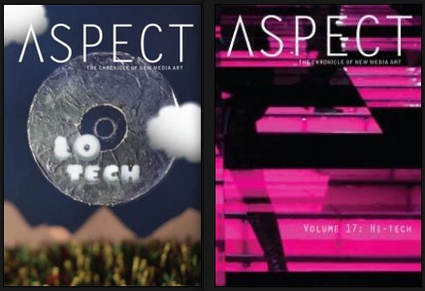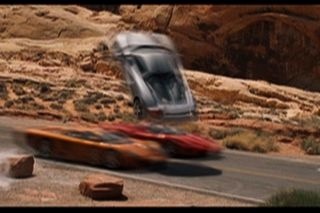 ASPECT Magazine releases periodically DVDs documenting works by 5-10 artists working in new or experimental media. The videos of the pieces can be viewed in their original version or accompanied by the audio commentary of an expert. The commentators usually start with a description of the work then they go deeper by bringing the work in the broader context of history/art history/history of technology, by revealing anecdotes about the career of the artist, by explaining the technological challenges of the work or highlighting the issues the artist wanted to raise.
ASPECT Magazine releases periodically DVDs documenting works by 5-10 artists working in new or experimental media. The videos of the pieces can be viewed in their original version or accompanied by the audio commentary of an expert. The commentators usually start with a description of the work then they go deeper by bringing the work in the broader context of history/art history/history of technology, by revealing anecdotes about the career of the artist, by explaining the technological challenges of the work or highlighting the issues the artist wanted to raise.
This week, i’ve been watching Volume 16: Lo-tech and Volume 17: Hi-Tech. The first presents nine artists who work with basic, or in some cases antiquated technology. As its name indicates, its ‘hi-tech’ counterpart features ten artists working at the intersection of new ideas in art and technology.
There were only a few names that were familiar to me in Lo-tech and Hi-tech and that’s good, i’m all for discovering new artists. One of the reasons of my ignorance might be that i tend to be a little too enwrapped in Europe and most of the artists and commentators in both volumes are North Americans (one notable exception is Arie Altena presenting with his delightful Dutch accent Marnix De Nijs‘s Beijing Accelerator.)
 I’ll just highlight a work that blew me away. Nikhil Murthy’s video Two Crashes (1926/2007) juxtaposes special effects that were regarded as “high tech” at the beginning of the 20th century to what was considered “high tech” at the beginning of the 21st. The first film is Buster Keaton’s The General (1926) that shows the most expensive stunt of the silent era: a real wood burning steam locomotive driven onto the burning bridge, where it collapses. The second scene shows the spectacular crash of a real Porsche Carerra GT in the film Redline (2007).
I’ll just highlight a work that blew me away. Nikhil Murthy’s video Two Crashes (1926/2007) juxtaposes special effects that were regarded as “high tech” at the beginning of the 20th century to what was considered “high tech” at the beginning of the 21st. The first film is Buster Keaton’s The General (1926) that shows the most expensive stunt of the silent era: a real wood burning steam locomotive driven onto the burning bridge, where it collapses. The second scene shows the spectacular crash of a real Porsche Carerra GT in the film Redline (2007).
The artist slowed-down and sped-up the video extracts according to data from two notorious stock market crashes: the ones of 1929 and 2008. The two clips are then edited together by rapidly flashing between the two films. Because of their differing speeds different combinations are seen throughout the video. It is always the same scenes, there are only two of them, yet the construction of the ensemble is mesmerizing. What is most annoying however is that i can’t find the video online, just the extract on ASPECT’s website.
New media art can do with it as much introspection and analysis as it can get and ASPECT does that in a very approachable yet precise and professional way.
Image on the homepage: Stephen Vitiello, Something Like Fireworks, 2010.
Previously: Magazine review: ASPECT – The Chronicle of New Media Art.
